How a Wall Can Help You Observe Revolved Half Moon Pose
“], “filter”: { “nextExceptions”: “img, blockquote, div”, “nextContainsExceptions”: “img, blockquote, a.btn, a.o-button”} }”>
Heading out the door? Study this textual content on the model new Exterior+ app obtainable now on iOS devices for members!
>”,”determine”:”in-content-cta”,”sort”:”hyperlink”}}”>Acquire the app.
Ever found your self in Revolved Half Moon, wobbling like crazy in your standing leg whereas awkwardly twisting your torso, desperately making an attempt to hold your gaze with out shedding your stability, and questioning if you’re even respiratory to not point out doing the pose “correct”?
Ardha Chandrasana will likely be…troublesome. Although one perk of your bodily yoga observe is that it helps to hone your sense of proprioception—that is, how or the place you are positioned in home—it might be troublesome to hunt out that sense in superior poses when various anatomical actions occur straight. Significantly when just a few of those actions are in elements of the physique you possibly can’t even see. If any type of balancing is anxious, as in Revolved Half Moon, that downside alone can occupy most of your consideration.
Due to this it’s advisable use a wall.
A wall is the yoga prop you not at all knew you wished—notably with reference to understanding the nuanced alignment of superior balancing poses. A wall supplies you one factor robust and concrete to push into with the aim of experiencing how that movement feels in your physique to have the ability to recreate it later with out the help of the wall. The tactile recommendations truly trains your proprioceptive senses for the actions you want to hold.
See moreover: 10 Beautiful Strategies to Use a Wall When Twisting
Simple strategies to be taught superior yoga poses on the wall
In Revolved Half Moon (along with Warrior III), you could observe the pose collectively together with your lifted foot pressed in opposition to a wall for stability, although doing solely which may be shortchanging your self of a whole lot of the revenue {{that a}} wall can present. Instead, you want to deconstruct a complicated posture into its anatomical actions and uncover them one after the opposite with the tactile recommendations of a wall. This helps you turn into acutely aware of varied elements of the pose which can in another case be misplaced as you attempt to do them .
Take Revolved Half Moon. The lower half of your physique is the standing L type of Virabhadrasana III (Warrior III) whereas the upper physique is rotated. Provided that this pose locations most of us on the upper end of our flexibility whereas moreover troublesome our stability, it’s easy to lose monitor of the details of the pose. As you battle to stabilize your standing leg, you might neglect to energise the unseen lifted leg. And in an effort to deepen the twist, you might take the pelvis with you as you flip your chest instead of specializing in rotating the shoulder blades and thoracic spine, which give increased benefits to increased physique posture and respiratory.
Everytime you observe exercises that isolate a particular side of how your physique needs to maneuver in Revolved Half Moon, the company help of the wall affords far more aim data than relying in your perceived place in home and helps focus your ideas on often-overlooked anatomical actions.
See moreover: Assemble Stability in Revolved Half Moon
A yoga sequence on the wall for Revolved Half Moon
On this sequence, you’ll stretch or push in opposition to a wall in quite a few positions. As quickly as you are feeling sturdy inside the specific particular person positions, you must use your heightened sense of proprioception to inform your observe even after you progress away from the wall.
You will have a clear a part of wall plus 2 yoga blocks (or water bottles or books).
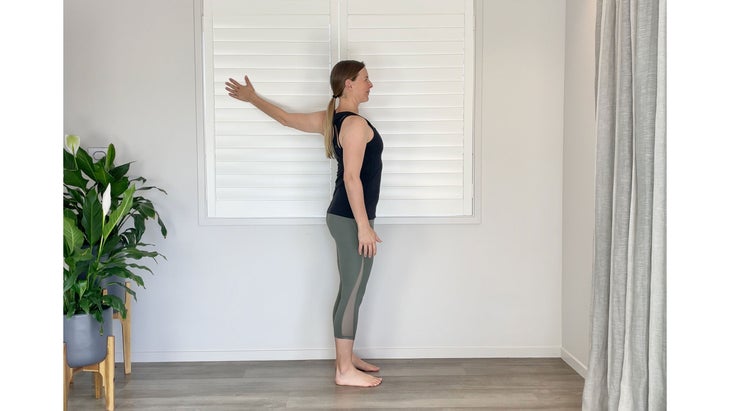
Shoulder Clocks
What it does: Begins to mobilize your shoulder blades and initiates rotation in your thoracic spine for the twist required by Revolved Half Moon.
Simple strategies to: Stand collectively together with your left facet 2–3 inches from the wall. Lengthen your left arm straight ahead of you, flip your palm in the direction of the wall, and press it into the wall. Attain your fingertips barely further away from you, which might require you to maneuver your shoulder blade away out of your spine. Slowly slide your hand overhead after which behind you until it’s barely above shoulder peak. Pause proper right here for a breath and actually really feel your left shoulder blade glide nearer to your spine and the left facet of your chest rotate in the direction of the wall. Then slide your left hand down in the direction of your left hip. Launch your hand from the wall and convey it once more out in entrance of you. Repeat for an entire of 4 circles. Repeat on the becoming facet.
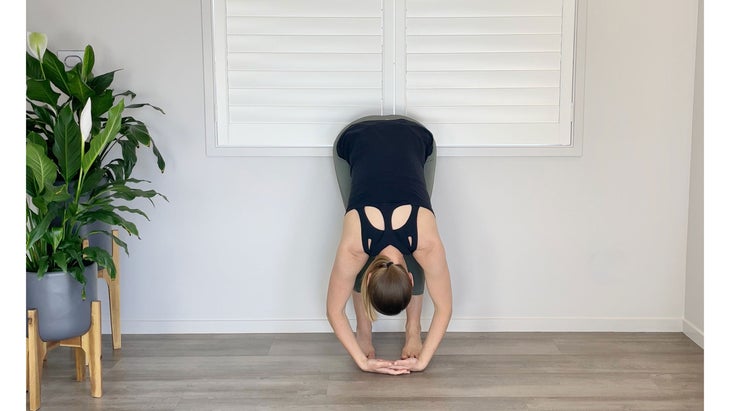
Standing Forward Bend on the Wall
What it does: Lengthens your hamstrings in preparation for the pliability required inside the standing leg of Revolved Half Moon.
Simple strategies to: Flip your once more to the wall, conserving your heels 2–3 inches away from it. Lean your sacrum in opposition to the wall, soften your knees, and fold forward over your thighs. Let your head and arms grasp heavy and gently tilt your sit bones up the wall until you are feeling a gentle stretch inside the abdomen of your hamstrings. Take 3–4 gradual and common breaths proper right here, then bend your knees adequate to plant your palms on the bottom in preparation for the following pose.
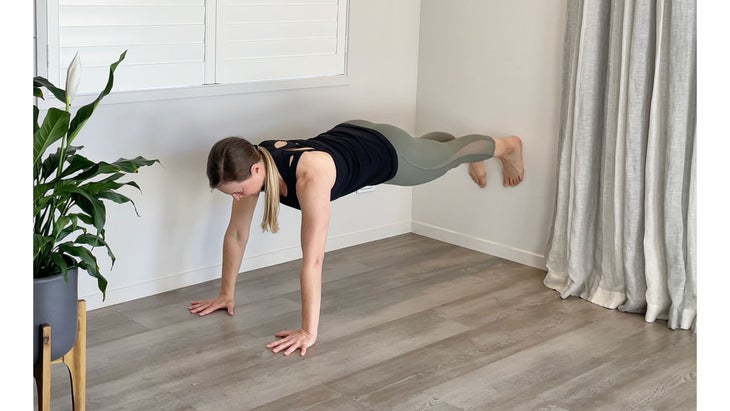
Plank on the Wall
What it does: Begins to ready the core and legs to create the scale and extension required by Revolved Half Moon.
Simple strategies to: Stroll your fingers away from the wall until your legs straighten and your wrists stack beneath your shoulders to ship you into Plank Pose. Elevate one leg and set the one of your foot on the wall at in regards to the an identical peak as your shoulders. Drive your fingers down and forward to create stress between that foot and the wall as you carry your second foot and set it on the wall hip-width from the first. Your wrists will now be barely forward of your shoulders. Hug your thigh muscle tissues in opposition to your thigh bones and cinch in spherical your waist to elongate out of your head to your heels. Keep for a breath or two, when you’ll be able to, then lower your ft once more to the bottom. Stroll your fingers once more to your ft, bend your knees, and rise as a lot as standing.
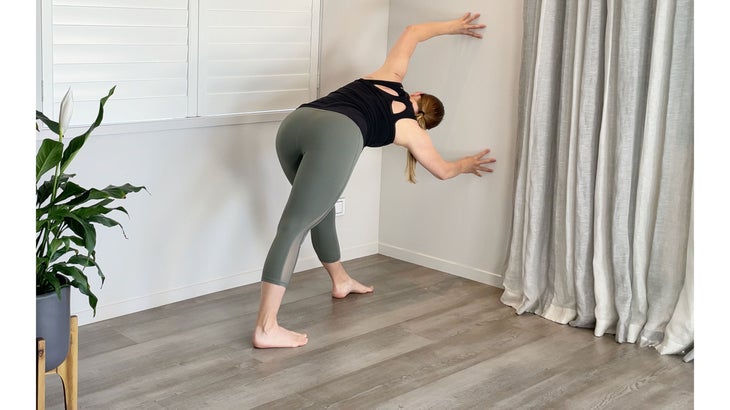
Revolved Triangle on the Wall
What it does: Quite a lot of the rotation in Revolved Half Moon is created by leverage from the shoulder blades. The underside shoulder strikes away from the spine (protracts) and the best shoulder strikes in the direction of the spine (retracts). These actions help rotate the chest and thoracic spine (the a part of the spine that attaches to the ribcage). So we now ship the sooner actions collectively and add the twist.
Simple strategies to: Flip to face the wall. Set your left foot just a few foot away from the wall and step your correct foot once more about 3 ft behind your left. Flip your correct toes out adequate to comfortably ground your correct heel with out turning your hips away from the wall. Then place your fingertips on the wall spherical hip peak, shoulder-width apart. Hinge at your hips and fold forward until your arms and spine are parallel to the bottom. Inch your ft further forward or once more, if wished, to completely straighten your arms. Distribute your weight evenly between every ft, drawing your left hip crease away from the left facet of your waist so that the two sides of your sacrum are stage. Press your palms into the wall and company in spherical your waist, drawing your pelvis away from the wall merely as you most likely did in plank collectively together with your ft on the wall.
Bend your elbows to hold onto your fingertips. As if you had been a clock, stroll your left fingertips in the direction of 12 o’clock and your correct fingertips in the direction of 6 o’clock, conserving your legs sturdy, hips stage, and waist slender as you rotate your increased once more and ribcage. Draw your left shoulder blade in the direction of your spine to hold that elbow in the direction of the ceiling, in an an identical movement as inside the Shoulder Clocks. Wrap your correct shoulder blade away out of your spine spherical your facet ribs that may help you switch that elbow in the direction of the bottom.
Take just a few breaths proper right here, feeling the soundness of your base distinction to the mobility of your shoulders and spine, then slowly retrace your steps on the second facet.
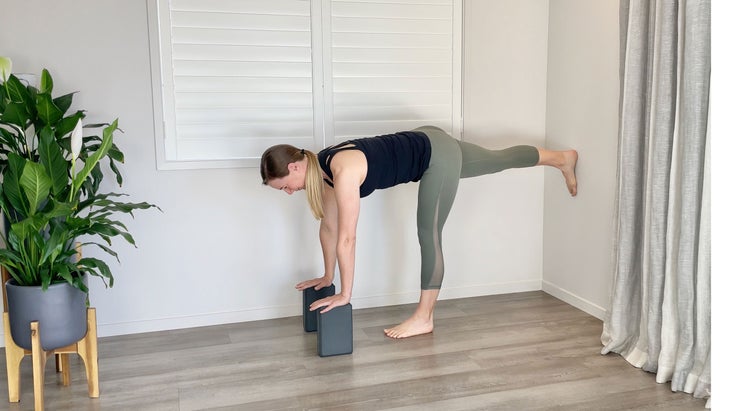
Warrior III on the Wall
What it does: Brings all these anatomical actions collectively: energy and steadiness inside the legs, hips stage, waist cinched to elongate the midsection, and the movement centered on the shoulder blades, ribcage, and better once more.
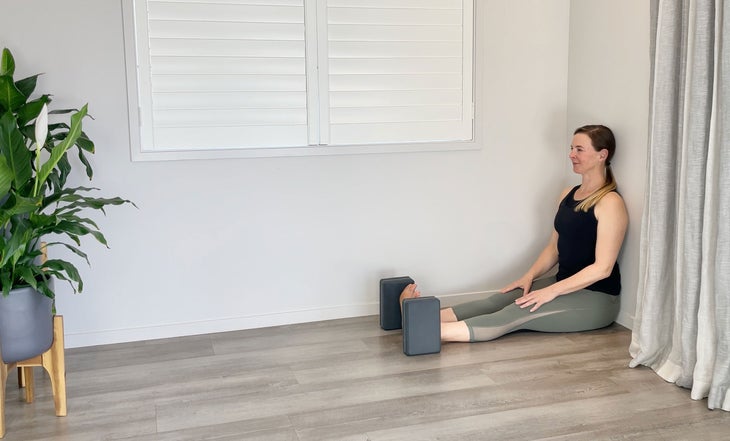
Simple strategies to: Sit on the bottom collectively together with your sacrum and once more in opposition to the wall and your legs straight in entrance of you. Set your blocks on each facet of your heels to mark your leg dimension from the wall.
Then come once more to standing. Set your left heel between the blocks, after which take the blocks in your fingers and stroll them away from the wall until they stack beneath your shoulders. Choose a block peak that helps your spine in a neutral type, parallel to the bottom. Common your weight inside the center of your left foot, then carry your correct foot and place it on the wall at hip peak with toes pointing straight down in the direction of the bottom. Be at liberty to bend your left knee to position barely slack in your hamstrings, nevertheless actively straighten your correct leg and drive out by way of your correct foot as if pushing the wall away from you, merely as you most likely did in Plank. Cinch in spherical your waist, lengthening the crown of your head away from the wall. Hold proper right here.
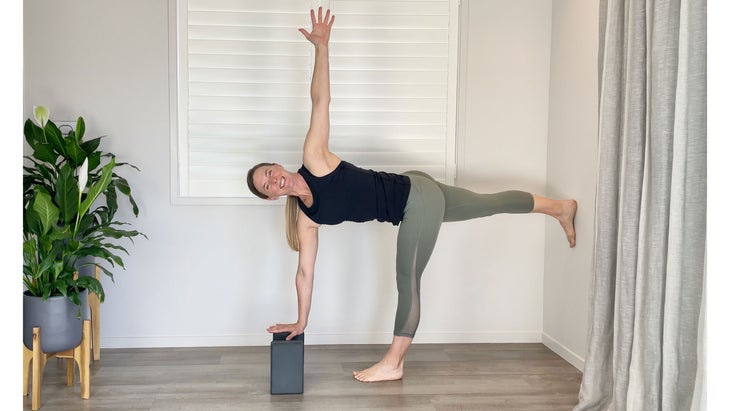
Revolved Half Moon on the Wall
What it does: Presents help as you technique Revolved Half Moon in all parts of your physique.
Simple strategies to: Slide the block in your correct immediately beneath your sternum, then push down by way of your correct hand to draw your correct shoulder blade away out of your spine to wrap spherical your facet ribs. Actually really feel how that movement initiates the rotation of your ribcage in the direction of the left. Float your left hand off your block, bend your left elbow, and draw it in the direction of the ceiling, squeezing your left shoulder blade close to your spine to help flip your chest further to the left. Straighten your left arm and attain it in the direction of the ceiling. Must you like, you could comply together with your fingertips collectively together with your gaze.
Keep proper right here for a breath or two as you push into the wall and floor to energise your legs and core. Use the leverage of your shoulder blades to rotate your chest. Then slowly once more out and repeat in your completely different facet.
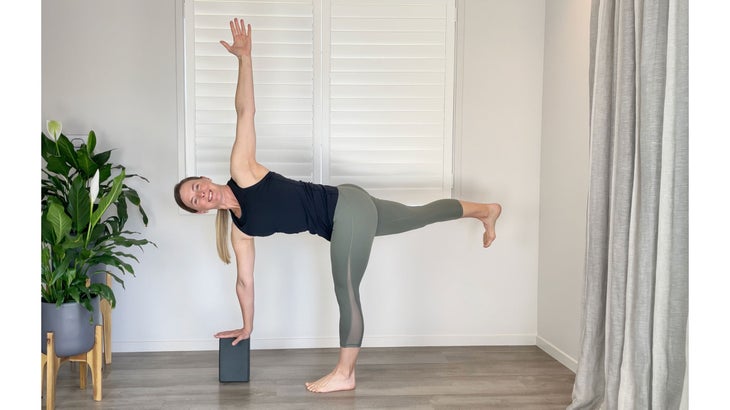
Revolved Half Moon Pose
What it does: When you could have prepared your physique inside the quite a few earlier exercises, the pose not feels pretty so befuddling in all its quite a few elements. You presumably can come into it with confidence.
Simple strategies to: Come into Revolved Half Moon as you most likely did inside the earlier mannequin in opposition to the wall, this time away from the wall. Proceed to push by way of your lifted leg, sustaining a stage pelvis and supportive core, and using your shoulder blades that may help you rotate your chest. Linger in Revolved Half Moon for a breath or two to notice the way in which it feels compared with what you normally actually really feel. Slowly launch and repeat on the alternative facet beginning with Revolved Triangle on the Wall.
See moreover: Simple strategies to Use a Wall for Photo voltaic Salutation A
About our contributor
Rachel Land is a Yoga Medicine trainer offering group and one-on-one yoga lessons in Queenstown New Zealand, along with on-demand at Observe.YogaMedicine.com. Passionate regarding the real-world utility of her analysis in anatomy and alignment, Rachel makes use of yoga to help her faculty college students create energy, stability, and readability of ideas. Rachel moreover co-hosts the model new Yoga Medicine Podcast.






